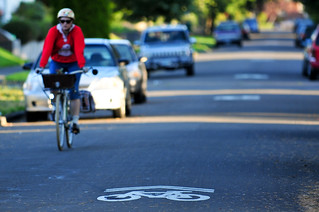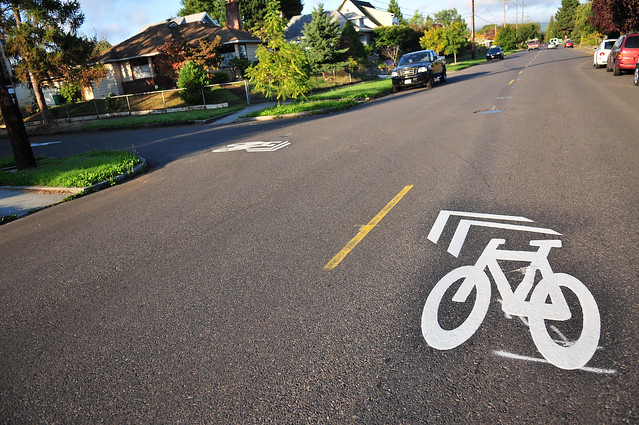Four years ago next month, a $1 million slice of the federal economic stimulus package started leaving its mark on Portland: 2,100 durable thermoplastic sharrow decals, intended to greatly increase the visibility of the city’s new neighborhood greenway network.
Now, as the city’s fog seal street maintenance efforts have been covering up sharrows, the city faces its first big decision about this bit of bike infrastructure: how to maintain them?
The good news is that the city is “committed to maintaining sharrows in good working order,” spokeswoman Diane Dulken said this week. “They could be thermoplastic, they could be paint, or they could be modified paint with extra beads for reflectivity.”
If they choose paint over thermoplastic, they plan to retouch the paint every year or two.
“As a rule, we paint our [bike] markings about once a year, but with sharrows they may have a longer lifespan — we’re thinking between one and two years — because one of the factors is traffic,” Dulken said. On lower-traffic neighborhood greenways, she said, painted sharrows will probably last longer than bike lanes along busy streets.
Sharrows are a very common bit of bike infrastructure in other U.S. cities, where they’re often used to mark a supposed bike route on the rightmost lane of a major street without forcing the city to actually devote street space to biking. In Portland, though, they’re placed down the middle of quiet neighborhood streets, and their double chevron arrows sometimes serve as wayfinding tools when a greenway jogs right or left:
Another city that uses sharrows on low-traffic streets is Vancouver BC, the city whose bike boulevards inspired Portland’s neighborhood greenways. When I was there last fall, the poor visibility of their painted sharrow markings was one of the few ways in which their network was inferior to Portland’s. I often struggled to see, as I passed perpendicular to a street, whether or not it had sharrows. Faded ones like this seemed common:
It’s great to hear that the city is committing to better maintenance of these markings that are uniquely important to our bike network. With the right care, this can be part of the federal stimulus package that keeps on giving.



